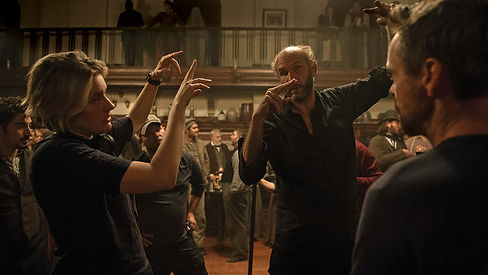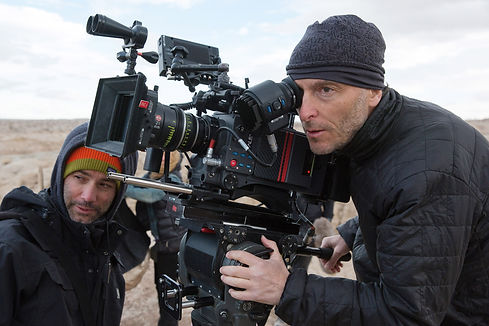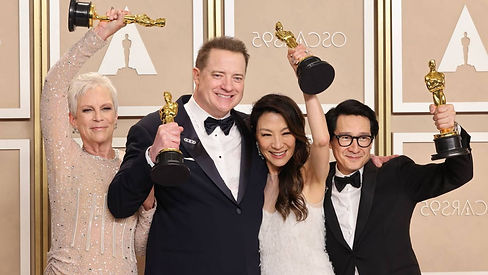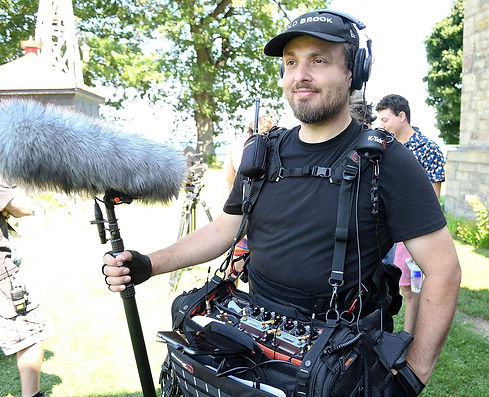
PLEASE BE AWARE THAT SOME OF THESE PAGES ARE UNDER MAINTAINANCE AND MAY BE UNAVAILABLE
Production
Capturing the production
CONTENTS OF PAGE
Roles
The most important thing to consider on set is your role. Your role will determine your responsibilities for your time in the production phase. Understanding what's required of you when you're performing each role is essential to the smooth running of the Production.
While these roles will all be helpful, you must consider the size of your team, your individual requirements, and any course specific requirements. Check with your teacher which of these roles are recommended for your production.
Note that the below roles are tailored for moving image productions, roles may vary slightly between types of productions. For example: a radio drama would not need a camera operator.
Click here for a video demonstrating the film roles on set with a skeleton crew.

Director
Manages the team and production
On set, the Director is responsible for overseeing the creative aspects of the production. They will be instructing the cast and crew on how to assist them in capturing their vision. They have the final say on creative and technical decisions, such as:
-
the shot type used
-
the positioning and colour of the lights
-
the blocking of the scene
They should also manage the start and end of takes. For more information on starting and ending takes, click here.
CAMERA OPERATOR
Captures the visuals
Camera operators capture the shots. They make sure the cameras, rigs, and lights are set up and ready to use. During filming, they will handle the camera and make sure that the composition, focus, and lighting of the shots are all what the Director wants, listening carefully to the Director at all times. They will set up the "first draft" of the shot according to the storyboard, lighting test shots etc, to be checked over by the Director before the shot is taken. They will start and stop the recording, monitoring the focus and framing in this time.


Talent
Appears in the production
Also referred to as cast or actors, "talent" are the personnel who will appear in the film. Their responsibility is to listen carefully to the Director's instructions and make sure they understand what is expected of them - asking if they are unsure of what to do.
SOUND TECHNICIAN
Captures the audio
Sound technicians will be responsible for capturing the audio on set at a good level for every take. They will inform the Director of any issues. They must operate the boom pole and TASCAM, carefully take note of all planned camera movements and lighting requirements to make sure the microphone and it's shadow is always hidden. They must capture approximately 1 minute of the ambient sounds (ROOM TONE) for each location.
This role may be split into Boom Operator and TASCAM operator. In this case, the TASCAM operator should take the lead.


production manager
Helps the Director to manage the logistics
Our Production Manager is responsible for placing/moving the set dressing according to the Director's instructions; monitoring the script & shot list to ensure no dialogue or shot is missed; ensuring continuity by monitoring that the actions are the consistent each take; photographing the scenes to ensure continuity between takes and for behind the scenes photography; taking notes on the camera log; and managing the clapperboard.
May be split into Script Supervisor (monitoring the continuity), Props Master (placing/moving the set dressing according to the Director's instructions), Grip (managing the clapperboard and general assistance), Behind the Scenes Photographer, and Producer (managing the shot list and camera log).
Assistant Director
Helps the Director manage the personnel
Our Assistant Director (AD) will do anything required to aid the shoat's progress. Even small details may cause delays, so ADs must be responsive to specific requests from the Director or other crew members. For example, the AD may, if required by the Director, assist the Production Manager with the camera record sheet and moving the lights, or with managing the clapperboard.

Castlefield filming protocol
PRIOR TO THE SHOOT DAY, the Director should have shared all paperwork and call times with the team so that they are aware of the running of the day and can ask any questions.
Production meetings should be held to ensure everyone understands what is required.
ON THE SHOOT DAY, the Director should have enough printed copies of the paperwork for each appropriate crew member to have what they need PLUS a spare. Below are the minimum requirements to make your shoot run smoothly, you may opt to have more (such as a character bio, mood board etc).
The Director and Actors should have access to the script.
The Camera Operator should have access to the script, storyboard, and lighting test shots.
The Production Manager should have access to the script, shot list, prop/costume/makeup list, risk assessment, floor plan, and camera log. (If there is an assistant Director on set, they can help the Production Manager with some of this.)
The Sound Technician should have access to the script and a sound log.
Before discussing the steps of arriving at and leaving Castlefield, you must be aware of the RULES OF WORKING IN THE SPACE.
-
Arrive at Castlefield at your scheduled call time
-
Follow the appropriate procedure when beginning and ending the shoot
-
Make sure you understand the requirements of your role, and ask if you are unsure
-
If you’re unsure how to use a piece of equipment, please ask the Technician for help
-
No food or drink allowed in Castlefield, only bottled water
-
Do not touch or move the flats unless supervised
-
Do not take equipment to the Studio or off-site without asking, this must be signed out properly
-
Be quiet and respectful when walking around the building, other people will likely be filming and any noise can cause delays or ruined footage
-
Close the doors behind you
-
Inform the Technician or a member of staff if you are leaving the building for any reason – even if it’s quick
Arriving at Castlefield
Each group member on set will have different responsibilities when arriving, please ensure you understand what you must do when you arrive.
Director
15 minutes before the scheduled shoot time, the Director will arrive
at the Office entrance to get paperwork checked, pick up the camera, and inform technician of who will be performing each role. Once completed, Directors will head to the Studio and begin setting up.
At the scheduled shoot time, they will collect the cast and crew from the main entrance. Anyone outside of your allocated group will need signing in on the sign in sheet.
(If not filming in a studio, please be aware that you do not need to sign the actors in)
Production manager
Arrive at the scheduled call time and wait by the back ramp entrance to be collected.
When entering the building, check the board to see who will be completing each role.
Collect the bibs, clapperboard, and any required documentation from the production hub. Distribute the bibs to the correct personnel Head to the Studio to assist the Director.
CAMERA OPERATOR
Arrive at the scheduled call time and wait by the back ramp entrance to be collected.
When entering the building, check the board to see who will be completing each role.
Straight to Studio to assist Director in setting up and discuss requirements for the shoot. If any additional camera kit is needed (such
as additional lenses, slider etc), they will collect this from the Technician's office.
Sound technician
Arrive at the scheduled call time and wait by the back ramp entrance to be collected.
When entering the building, check the board to see who will be completing each role.
To Technician Office to collect the sound equipment, then to the Studio space.
assistant director
Arrive at the scheduled call time and wait by the back ramp entrance to be collected.
When entering the building, check the board to see who will be completing each role.
Check with Director, as different shoots may require different support from the AD.
talent
Arrive at the scheduled call time and wait by the back ramp entrance to be collected.
When entering the building, check the board to see who will be completing each role.
Straight to the Studio space to await instructions from the Director.
leaving Castlefield
As mentioned earlier, if you are leaving the building at any time, even quickly, you must let the technician or a member of staff know.
Each group member on set will have different responsibilities at the end of the shoot, please ensure you understand what you must do when you arrive.
Director
Remove the SD card and battery from the camera. Escort any actors
out of the building and ensure they have signed out, then put the SD card and camera battery in the appropriate basket in the office (shown below). If filming externally or in one of the add-on Studios, choose one of the empty baskets and let the Technician know which is yours so they can write your name on it.
Head back to the Studio and start packing down the room. The lights should be turned off at the wall and the Studio should be tidy. All your props and paperwork should be removed.
Production manager
Collect the bibs, badges, and clapperboard. Return to the Production hub, then assist the Director in tidying the space.
CAMERA OPERATOR
Once the battery and SD card have been taken out of the camera, pack
down the camera and any additional equipment, and bring to the Technician's office. Do not remove any of the kit that was in the space when you arrived such as lights/tripods. Once the kit is returned, assist the Director in tidying the space.
Sound technician
Bring all sound equipment to the Technician office. Remove the TASCAM SD card and place in the appropriate basket. Give the
boom pole to the technician and hang the XLR cable on an empty hook. Wrap up the headphones and place in the appropriate basket. Once the kit is returned, assist the Director in tidying the space.
assistant director
Assist the Director in tidying the space.
talent
Leave the building immediately.
Starting and stopping a recording
MINIMUM TEAM NEEDED:
• Director
• Production Manager
• Director of Photography (DOP) / Camera Operator
• Sound Technician
• Actors / Talent
The team will begin preparing the shot according to the shot list. The Director will work with the actors while the DOP starts setting up a "first draft" of the shot, using the storyboard as a guide for what it should look like. The production manager will move anything that needs moving such as lights, props etc, using the floor plan and lighting plan, and communicating with the DOP to ensure it looks well framed.
Once the Director has finished working with the actors and is sure they know what they're doing, they will check the "first draft" shot that they crew have laid out, and instruct them to make changes if necessary.
When everything is set up and everyone is ready to do a take, the Director will call for "quiet
on set" to let everyone know that the recording is about to begin. In this time, the
Production Manager will stand in the frame with the clapperboard.
Once quiet, the DOP will press the record button and let everyone know by saying "camera
rolling". They will ensure that the clapperboard is in focus and in the shot.
Once the camera is recording, the Sound Technician will record on the TASCAM and say
"sound rolling" to make the team aware.
Once the camera and sound are recording, the Production Manager will call the TITLE OF
THE FILM, SHOT, and TAKE before clapping the board and walking out of the frame to stand
by the Director.
The DOP may need to adjust the focus in this time, but once they are sure the shot is
focused correctly, they will say "camera set" to let the Director know that everything is
ready to go.
The Director will call "Action" to let the actors know to begin. The Actors should wait for
approximately 3-5 seconds before beginning. (This will help in the edit).
During the take, the Director and Production Manager will be closely watching the monitor
to keep an eye on continuity and performance. If either notice any issues, these should be
written in the CAMERA LOG.
If the Director feels another take should be done for whatever reason, they should explain
the reasons to the cast and crew. If they feel that the take was right, they should check with
the DOP and Sound Technician that they didn't notice any issues.
If they did not notice any issues, the Director will watch the take back again. If they are sure
there were no problems, the Production Manager will tick the shot off the shot list and say which shot is next.
The team will begin preparing the next shot according to the shot list.